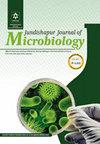Comparison of Respiratory Microbiota in Patients with and Without Hospital-Acquired Infection
IF 0.5
4区 医学
Q4 MICROBIOLOGY
引用次数: 0
Abstract
Background: Nosocomial infections have increased among patients admitted to the intensive care unit (ICU). Objectives: This study investigated the microbiota pattern of the respiratory system in hospitalized patients with treatment-resistant respiratory infections compared to those without treatment-resistant respiratory infections. Methods: This case-control study utilized sputum samples from hospital-acquired infection (HAI) and non-HAI (NHAI) patients over 52 years old hospitalized in the ICU. Identification and determination of the drug sensitivity of the bacteria responsible for treatment-resistant respiratory infections were made by culture method in selective and differential media and VITEK 2 device. Finally, quantitative polymerase chain reaction (qPCR) was used to analyze the microbiota of the respiratory system. Results: Excessive prescription of antibiotics, long hospitalization, and history of surgery were important risk factors for nosocomial infections. The study of antibiotic resistance of pathogens causing hospital infections indicated their high resistance to most common antibiotics. Also, nosocomial infections led to a change in lung microbiota in HAI patients. The frequencies of Streptococcus pyogenes, S. pneumoniae, and Haemophilus influenzae were higher in patients with treatment-resistant respiratory infection (P < 0.05), but the frequency of Neisseria spp. was higher in patients without treatment-resistant respiratory infection (P < 0.05). Conclusions: The pathogens responsible for nosocomial infections had acquired resistance to a wide range of antibiotics, leading to changes in their respiratory microbiota.医院获得性感染患者与非医院获得性感染患者呼吸道微生物群比较
背景:重症监护病房(ICU)住院患者的院内感染有所增加。目的:本研究探讨了治疗耐药呼吸道感染住院患者与非治疗耐药呼吸道感染住院患者呼吸系统的微生物群模式。方法:本病例对照研究使用医院获得性感染(HAI)和非HAI (NHAI)患者的痰样本,年龄大于52岁。采用选择性和差异培养基培养法和VITEK 2装置对耐药呼吸道感染病原菌进行药敏鉴定和测定。最后,采用定量聚合酶链反应(qPCR)对呼吸系统微生物群进行分析。结果:抗生素处方过量、住院时间长、手术史是院内感染的重要危险因素。医院感染病原菌的耐药性研究表明,病原菌对大多数常见抗生素具有较高的耐药性。此外,医院感染导致HAI患者肺部微生物群的变化。化脓性链球菌、肺炎链球菌和流感嗜血杆菌在治疗耐药呼吸道感染患者中出现频率较高(P < 0.05),而奈瑟菌在非治疗耐药呼吸道感染患者中出现频率较高(P < 0.05)。结论:引起医院感染的病原菌对多种抗生素产生耐药性,导致其呼吸道菌群发生变化。
本文章由计算机程序翻译,如有差异,请以英文原文为准。
求助全文
约1分钟内获得全文
求助全文
来源期刊

Jundishapur Journal of Microbiology
MICROBIOLOGY-
CiteScore
1.30
自引率
0.00%
发文量
56
审稿时长
6-12 weeks
期刊介绍:
Jundishapur Journal of Microbiology, (JJM) is the official scientific Monthly publication of Ahvaz Jundishapur University of Medical Sciences. JJM is dedicated to the publication of manuscripts on topics concerning all aspects of microbiology. The topics include medical, veterinary and environmental microbiology, molecular investigations and infectious diseases. Aspects of immunology and epidemiology of infectious diseases are also considered.
 求助内容:
求助内容: 应助结果提醒方式:
应助结果提醒方式:


